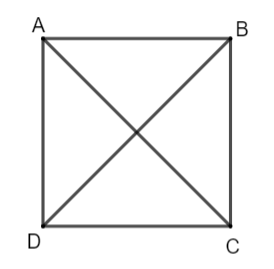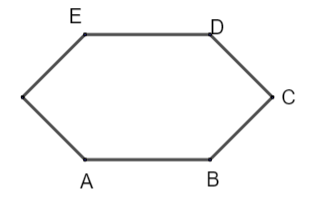
Find the number of diagonals in the polygon of n sides.
Answer
590.4k+ views
Hint: First write definitions of polygon and look at the possible sides and vertices. Now look at the definition of the diagonal of a polygon. Now list the possible vertices for which we can get a diagonal. Now add all the possibilities in an intelligent way to find the total number of diagonals. After getting a number of diagonals, check the values for any known polygon for verification.
Complete step-by-step answer:
Polygon: - In general geometry polygon is defined as a plane figure that is described by a finite number of straight line segments connected to form a closed polygon chain. It is also defined as the solid region of a plane bounded by a bunch of line segments. Also called bounded circuit.
Diagonal of polygon: - Diagonal is a line segment which joins any two non – consecutive vertices. Consecutive vertices from edges so only 2 diagonals possible. For any convex polygon diagonals lie inside the polygon. Example: - square.

Take n – sided polygon ABCDE.

Pick any vertex of the polygon. Now we have (n - 1) other vertices to form a line segment. We know adjacent vertices from edges not diagonal. Any vertex has 2 adjacent vertices one after, one before. By subtracting these 2 vertices, the possibilities become:
(n - 3) possibilities
As there are n vertices for n sided polygon.
By multiplying with n for possibilities, we get:
n (n - 3)
We are counting each diagonal twice because AC is connected at A and CA is counted as C but both are the same.
This is done with every diagonal.
So, by dividing 2 for the possibilities, we get:
Number of diagonals = \[\dfrac{n\left( n-3 \right)}{2}\] - (1)
Verification for square: n = 4
By substituting n = 4 in equation (1), we get,
Number of diagonals = \[\dfrac{4\left( 4-3 \right)}{2}=\dfrac{4\times 1}{2}=2\].
So, the number of diagonals for squares is 2 which is true. So, the formula (1) is correct.
Therefore, the number of diagonals for n sided polygon are given by \[\dfrac{n\left( n-3 \right)}{2}\].
Note: Be careful don’t forget to divide by 2 because of repeated counting of each diagonal. Alternate method is to use minor tricks. It is described as follows: Every two vertices form an edge or diagonal. Thus these are \[{}^{n}{{C}_{2}}\] number of pairs which is equal to sum of number of edges and diagonal. So, \[{}^{n}{{C}_{2}}\] - number of edges is number of diagonals where n is number of edges. So, number of diagonals are \[{}^{n}{{C}_{2}}\] - n, which is simplified as \[\dfrac{n\left( n-1 \right)}{2}\] - n which can be written as \[\dfrac{n\left( n-3 \right)}{2}\], which is same result as above.
Complete step-by-step answer:
Polygon: - In general geometry polygon is defined as a plane figure that is described by a finite number of straight line segments connected to form a closed polygon chain. It is also defined as the solid region of a plane bounded by a bunch of line segments. Also called bounded circuit.
Diagonal of polygon: - Diagonal is a line segment which joins any two non – consecutive vertices. Consecutive vertices from edges so only 2 diagonals possible. For any convex polygon diagonals lie inside the polygon. Example: - square.

Take n – sided polygon ABCDE.

Pick any vertex of the polygon. Now we have (n - 1) other vertices to form a line segment. We know adjacent vertices from edges not diagonal. Any vertex has 2 adjacent vertices one after, one before. By subtracting these 2 vertices, the possibilities become:
(n - 3) possibilities
As there are n vertices for n sided polygon.
By multiplying with n for possibilities, we get:
n (n - 3)
We are counting each diagonal twice because AC is connected at A and CA is counted as C but both are the same.
This is done with every diagonal.
So, by dividing 2 for the possibilities, we get:
Number of diagonals = \[\dfrac{n\left( n-3 \right)}{2}\] - (1)
Verification for square: n = 4
By substituting n = 4 in equation (1), we get,
Number of diagonals = \[\dfrac{4\left( 4-3 \right)}{2}=\dfrac{4\times 1}{2}=2\].
So, the number of diagonals for squares is 2 which is true. So, the formula (1) is correct.
Therefore, the number of diagonals for n sided polygon are given by \[\dfrac{n\left( n-3 \right)}{2}\].
Note: Be careful don’t forget to divide by 2 because of repeated counting of each diagonal. Alternate method is to use minor tricks. It is described as follows: Every two vertices form an edge or diagonal. Thus these are \[{}^{n}{{C}_{2}}\] number of pairs which is equal to sum of number of edges and diagonal. So, \[{}^{n}{{C}_{2}}\] - number of edges is number of diagonals where n is number of edges. So, number of diagonals are \[{}^{n}{{C}_{2}}\] - n, which is simplified as \[\dfrac{n\left( n-1 \right)}{2}\] - n which can be written as \[\dfrac{n\left( n-3 \right)}{2}\], which is same result as above.
Recently Updated Pages
Master Class 10 Science: Engaging Questions & Answers for Success

Master Class 10 Social Science: Engaging Questions & Answers for Success

Master Class 10 Maths: Engaging Questions & Answers for Success

Master Class 10 English: Engaging Questions & Answers for Success

Class 10 Question and Answer - Your Ultimate Solutions Guide

Two men on either side of the cliff 90m height observe class 10 maths CBSE

Trending doubts
Why is there a time difference of about 5 hours between class 10 social science CBSE

Write a letter to the principal requesting him to grant class 10 english CBSE

What is the median of the first 10 natural numbers class 10 maths CBSE

The Equation xxx + 2 is Satisfied when x is Equal to Class 10 Maths

Which of the following does not have a fundamental class 10 physics CBSE

State and prove converse of BPT Basic Proportionality class 10 maths CBSE




